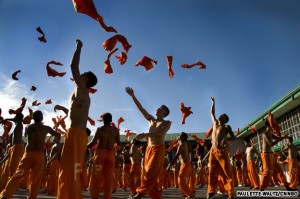In 2007, the Cebu Provisional Detention and Rehabilitation Center (CPDRC) maximum-security prison in the Philippines implemented dance classes for all of its inmates to participate in daily as part of their rehabilitation program. Each month, dances that feature all 1500 inmates are performed free to the public, which seem to be an uplifting experience for both the performers and the audience. In addition to the Thriller dance, the prisoners also have performed dance routines to the Black Eyed Peas, which contained a dance combination of drill and Cha Cha, We Built This City by Starship, and Low by Flo Rida.
Since the program’s beginning, its popularity has grown and it has become a sensation on You Tube. I saw this video a year ago, and was completely stunned that prison inmates would collaborate together to rehearse and perform a choreographed dance routine. Having little exposure to prison life other than what is depicted by the media, rehearsing Michael Jackson’s “Thriller” is not what I expected to see from convicted inmates in a maximum-security prison. But as the dance progressed, it became apparent that there was a high level of commitment invested to the technical dance moves and characterizations. The audience reception was just as surprising as most of the public cheered and applauded; temporarily forgetting that approximately 70% or the inmates were convicted of murder, rape, or drug trafficking.
As CPDRC has gained more attention, it has also received an increase in criticism. Rumors circulating have suggested that the rehearsals have reached upwards of 10 hours a day, and prisoners have no choice but to participate or run the risk of “disappearing.” Byron Garcia, prison security advisor, denies that the inmates are forced to dance and defends himself by saying, “My fellow citizens of the world, cruel and violent forms of punishment are a thing of the past. If we make jails a living hell for the prisoners, then, we might just be sending out devils once they are released and re-integrated to society.”1
According to the National Institute of Justice website (NIJ), a 1994 statistics tracker of parolees found that 52% were arrested again and placed back in prison within three years of their release. In looking at how the prisons themselves impact inmates, NIJ researchers had surprising results.
“The theory is that differential placement may affect post-release crime rates (recidivism) but not necessarily as intended. Higher security prisons are more punitive and, therefore, should decrease recidivism among inmates who have equivalent propensities to commit crime. Research shows, however, that being exposed to inmates who have higher propensities to crime may increase criminal behavior or reinforce antisocial attitudes.”2
Finding similar evidence for Philippines’ prisons is challenging, but in a New York Times article, one of the inmates does note the decrease in drugs and alcohol. Another inmate commented, “I like dancing. It is a way we get to show the world that even if we ended up in prison, we are not totally damaged people.”3
In this sense, the monthly performances could potentially create an unexpected connection from the public to the inmates by removing social stigma and re-humanizing the inmates in the perception of society. As the NIJ research supports, the U.S. prison system that is intended to be rehabilitative is more often a demoralizing experience that leaves those who are paroled without tools to reacclimatize into society. According the NIJ research, the dehumanizing effect of prisons and the lack of true community connections are the contributing factors in recidivism. This increased antisocialism in turn, makes prisoner reentry back into the community more challenging and creates an almost inescapable cycle of crime.
This leaves me wondering: are these monthly performances beneficial for the inmates and the public who sees them? During the dance performances, the inmates continue to wear their prison jumpsuits, serving as a constant reminder to the audience of their place in society. However, by linking the prisoners to a popular, recognizable form of entertainment in mainstream society, is the identity of the inmates being reconstructed or are they just being exploited? Many of the inmates seem to enjoy the attention, and the public is willing to travel to the prison to watch them dance. But in doing so, are the inmates being reduced to a superficial form of entertainment, contained within a large, barred space that could possibly be read as a human zoo? It is difficult to know if the prisoners are truly operating within their own will to willingly perform for the public or if this is being used as a tool by the prison administration to garner public attention and solicit for donations. I want to believe that this kind of program is edifying for both the inmates and community alike, but without knowing what really goes on behind the prison walls, I’m not so sure.
Works Cited
[1] CPDRC maximum-security prison in the Philippines has 1500 inmates who enjoy its dance exercise program. Could this work in America? November 2009.
[2] National Institute of Justice: Impact of Prison Experience on Recidivism.
http://nij.gov/nij/topics/corrections/recidivism/prison-experience.htm
[3] Seno, Alexandra. Dance is part of rehabilitation at Philippine prison. The New York Times. January 15, 2008.
http://www.nytimes.com/2008/01/15/world/asia/15iht-inmates.1.9223130.html?pagewanted=2

